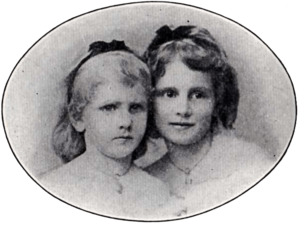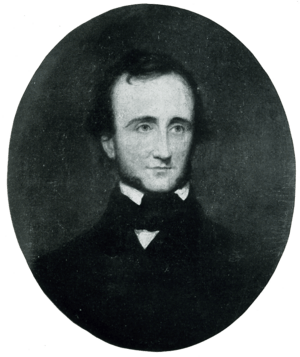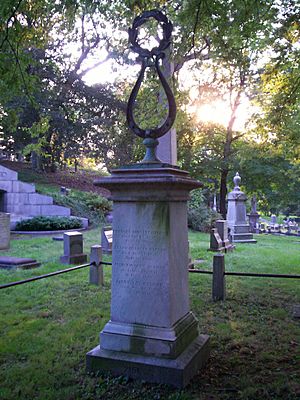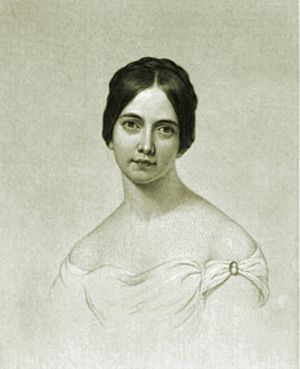Frances Sargent Osgood facts for kids
Quick facts for kids
Frances Sargent Osgood
|
|
|---|---|
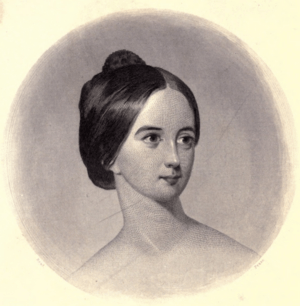
Osgood in an 1849 anthology
|
|
| Born |
Frances Sargent Locke
June 18, 1811 Boston, Massachusetts, U.S.
|
| Died | May 12, 1850 (aged 38) New York City, U.S.
|
| Occupation | Poet |
| Spouse(s) | |
| Children | 3 |
| Signature | |
Frances Sargent Osgood (born Frances Sargent Locke; June 18, 1811 – May 12, 1850) was a famous American poet. She was one of the most popular women writers of her time. People sometimes called her "Fanny." She was also known for exchanging poems with the famous writer Edgar Allan Poe.
Contents
Life Story
Growing Up
Frances Sargent Locke was born in Boston, Massachusetts. Her father, Joseph Locke, was a rich merchant. Her mother was Mary Ingersoll Foster. Frances had several brothers and sisters, including another writer named Andrew Aitchison Locke.
She grew up in Hingham, Massachusetts. As a young woman, she went to a special school called the Boston Lyceum for Young Ladies. Frances started writing poetry when she was young. Her first poems were published when she was fourteen. They appeared in a magazine for children's poetry called Juvenile Miscellany. The editor was Lydia Maria Child.
Marriage and Family
In 1834, Frances met Samuel Stillman Osgood. He was a young artist who painted portraits. They met at the Boston Athenæum while Frances was writing poems inspired by paintings. Samuel asked her to pose for a portrait. They got engaged before the painting was finished. They married on October 7, 1835.
After they married, Frances and Samuel moved to England. Their first daughter, Ellen Frances, was born there on July 15, 1836. In 1838, Frances published her first collection of poems in England. It was called A Wreath of Flowers from New England. This book included a play in verse called Elfrida. She then published another poetry book, The Casket of Fate.
The Osgoods returned to Boston in 1839 after Frances's father passed away. Their second daughter, May Vincent, was born on July 21, 1839. After that, they moved to New York City. Frances became a well-known person in New York's writing community. She wrote a lot, and many of her works appeared in popular magazines. Sometimes, she used pen names like "Kate Carol" or "Violet Vane."
Some of her other books include The Poetry of Flowers and the Flowers of Poetry (1841). She also wrote children's books like The Snowdrop, a New Year Gift for Children (1842), Rose, Sketches in Verse (1842), and Puss in Boots (1842).
Frances Osgood's third daughter, Fanny Fay Osgood, was born in June 1846.
Friendship with Edgar Allan Poe
In February 1845, Edgar Allan Poe gave a talk in New York. He praised Frances Osgood's poetry, saying she had a bright future. Frances was very impressed by his compliment. Poe was known for being a very strict critic.
Poe and Osgood likely met in person in March 1845. They were introduced by their friend Nathaniel Parker Willis. Poe's wife, Virginia, was unwell at the time.
In 1845, Poe helped publish some of Osgood's poems in the Broadway Journal magazine. These included poems like "The Rivulet's Dream" and "Love's Reply." Poe also wrote poems in response, sometimes using a pen name. One famous poem was "A Valentine." This poem was a riddle that spelled out Osgood's name. Many people believe their friendship was purely platonic, meaning it was a close, non-romantic friendship.
Poe's wife, Virginia, even approved of their friendship. She often invited Osgood to their home. Virginia believed that Osgood's friendship had a good influence on Poe.
Another poet, Elizabeth F. Ellet, spread rumors about Poe and Osgood's friendship. Osgood wanted to protect her reputation. She asked Poe to return her personal letters so she could destroy them. In July 1846, Samuel Osgood demanded that Ellet apologize to Frances. Ellet did apologize and blamed Poe and his wife. Frances Osgood and Edgar Allan Poe did not interact after 1847.
Poe was not the only person who wrote admiring poems to Osgood. Other men, like Rufus Wilmot Griswold, also showed their admiration. Osgood even dedicated a book of poetry to Griswold. The friendly competition between Griswold and Poe for Osgood's attention might have led to their famous rivalry.
Later Life and Death
Frances and her husband Samuel got back together in 1846. They moved to Philadelphia for a short time to get away from the rumors. Even though Frances was sick, she kept writing. By 1847, she was mostly confined to her room because of her illness. Her poems from this time often showed her concern for her daughters, who were then eleven and eight years old.
Her husband, Samuel, struggled to earn money as a painter. He left again in 1849 to join the California Gold Rush. However, he returned home shortly before Frances passed away.
Frances Osgood died from tuberculosis in 1850 at her home in New York. By the end, she could no longer speak. Her last word, "angel," was written on a slate to her husband. She was buried in her parents' plot at Mount Auburn Cemetery in Cambridge, Massachusetts.
In 1851, her friends published a collection of her writings. It was called The Memorial, Written by Friends of the Late Mrs. Frances Sargent Locke Osgood. This book was reissued in 1854 as Laurel Leaves. It was meant to raise money for her headstone. However, a writer named Fanny Fern noticed that by 1854, the grave still had no marker. She criticized Samuel Osgood for this. Samuel Osgood later announced that he had designed a monument. It was inspired by Frances's poem "The Hand That Swept the Sounding Lyre." The monument was soon put in place.
Frances Osgood's two daughters passed away the year after their mother. May Vincent Osgood died on June 26, 1851, and Ellen Frances died on August 31, 1851.
Her Writing Style
Frances Osgood wrote a lot of poems and stories. Her work appeared in many of the top magazines of her time. She was one of the most admired women poets in the mid-1840s. Even though she was a shy person, Osgood was very open in her writing. She often wrote about her relationships with others.
Much of her work was love poetry. But she also wrote poems for her mother, sister, husband, and friends. Her poems about her children were not just sweet. A literary historian named Emily Stipes Watts said they were "honest attempts to express thoughts and emotions never so fully expressed before by women in poetry." They showed her true care for her children's growth and happiness.
Rufus Wilmot Griswold once said that she wrote poems "with almost the fluency of conversation." Edgar Allan Poe reviewed her work. He wrote that she was "absolutely without rival" in America or England. He praised her poetry collection A Wreath of Flowers from New England. Poe said it showed "deep feeling and exquisite taste" and deserved to be read by more people.
Selected Works
- A Wreath of Flowers from New England (1838)
- The Casket of Fate (1839)
- The Poetry of Flowers and the Flowers of Poetry (1841)
- The Snowdrop, a New Year Gift for Children (1842)
- Rose, Sketches in Verse (1842)
- Puss in Boots (1842)
- The Marquis of Carabas (1844)
- Cries in New York (1846)
- The Memorial, Written by Friends of the Late Mrs. Frances Sargent Locke Osgood (published after her death in 1851)
- Laurel Leaves (published after her death in 1854)
See also
 In Spanish: Frances Sargent Osgood para niños
In Spanish: Frances Sargent Osgood para niños
- "To Frances" poem by Edgar Allan Poe
- "To F——s S. O——d" poem by Edgar Allan Poe
- Sarah Elmira Royster – A childhood friend of Poe
- Sarah Helen Whitman – Had a similar friendship with Poe
- Impromptu. To Kate Carol by Edgar Allan Poe
- Anna Maria Wells
Sources
- Child, Lydia Maria Francis. The Juvenile Miscellany. Boston, Mass: Printed and published by John Putnam, 1826. worldcat.org Accessed January 27, 2008
- Locke, John G. Book of the Lockes. A Genealogical and Historical Record of the Descendants of William Locke, of Woburn. Boston: J. Munroe and co, 1853. (p. 139) (Google Books). Accessed January 30, 2008
- Meyers, Jeffrey. Edgar Allan Poe: His Life and Legacy. Cooper Square Press, 1992. ISBN: 0-8154-1038-7.
- Moss, Sidney P. Poe's Literary Battles: The Critic in the Context of His Literary Milieu. Southern Illinois University Press, 1969.
- Quinn, Arthur Hobson. Edgar Allan Poe: A Critical Biography. Baltimore: The Johns Hopkins University Press, 1998. ISBN: 0-8018-5730-9
- Silverman, Kenneth. Edgar A. Poe: Mournful and Never-ending Remembrance. Harper Perennial, 1991. ISBN: 0-06-092331-8.
- Sova, Dawn B. Edgar Allan Poe: A to Z. New York: Checkmark Books, 2001. ISBN: 0-8160-4161-X.
- Watts, Emily Stipes. The Poetry of American Women from 1632 to 1945. Austin, Texas: University of Texas Press, 1978. ISBN: 0-292-76450-2


